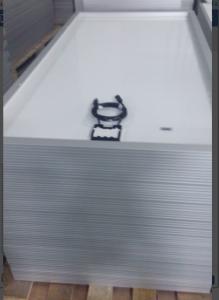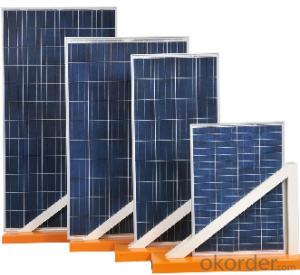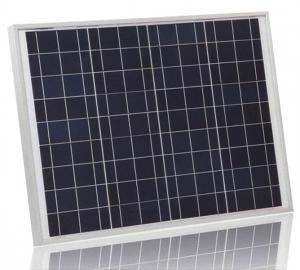The Best 20W CNBM Polycrystalline Silicon Solar Panels for Home
- Loading Port:
- China main port
- Payment Terms:
- TT OR LC
- Min Order Qty:
- 100 watt
- Supply Capability:
- 1000 watt/month
OKorder Service Pledge
OKorder Financial Service
You Might Also Like
Specification
20W CNBM Polycrystalline Silicon Panel for Home Using
Production description
Emerging, third generation solar technologies use advanced thin-film cells. They produce a relatively high-efficiency conversion for the low cost compared to other solar technologies. Also, high-cost, high-efficiency, and close-packed rectangular multi-junction (MJ) cells are preferably used in solar panels on spacecraft, as they offer the highest ratio of generated power per kilogram lifted into space. MJ-cells are compound semiconductors and made of gallium arsenide (GaAs) and other semiconductor materials. Another emerging PV technology using MJ-cells is concentrator photovoltaics (CPV).

Feature
Long-term stability,reliability and performance
Low breakage rate
Color uniformaity
credit on customers
overseas storage
Physical characteristic
1. Rigorous quality control meets the highest international standards.
2. High-transmissivity low-iron tempered glass, strong aluminium frame.
3. Using UV-resistant silicon.
4. IS09001/14001/CE/TUV/UL
- Q: How can I determine the size of solar panel system I need?
- To determine the size of the solar panel system you need, you should consider factors such as your energy consumption, available roof space, and geographical location. Start by analyzing your average monthly electricity usage to estimate the amount of energy your solar panels should produce. Next, assess your roof's orientation, tilt, and shading to make sure it can accommodate the necessary number of panels. Lastly, consider your location's sunlight hours and climate conditions, as they affect the efficiency and output of solar panels. Consulting with a professional solar installer can also help you accurately determine the size of the solar panel system you need.
- Q: How do solar panels impact air pollution?
- Solar panels have a positive impact on air pollution as they produce clean, renewable energy without emitting any harmful pollutants or greenhouse gases. By reducing the reliance on fossil fuels for electricity generation, solar panels help to decrease air pollution, improve air quality, and mitigate the harmful effects of climate change.
- Q: Can solar panels be used in areas with extreme temperatures?
- Yes, solar panels can be used in areas with extreme temperatures. Solar panels are designed to withstand a wide range of temperatures, including both extreme heat and cold. However, it's important to note that extreme temperatures can affect the efficiency and performance of solar panels. High temperatures can cause a slight reduction in energy output, while extremely low temperatures can decrease the efficiency temporarily. Nonetheless, solar panels are still a viable and effective renewable energy solution in areas with extreme temperatures.
- Q: This is the cenario. Your yearly energy use comes by mail and it states that the total amount of energy used your household is 7000kWh.Then you make the decision of switching to get solar panels. The question is what area should your solar panel be given that the average annual length of daylight is 2.0.
- It is not that simple. There are 3 main types of solar cells. Monocrystalline silicon is the most efficient and produces the smallest solar cells, and therefore the smallest panels. Poly-crystalline (or multi-crystalline) silicon produces the next most efficient type of cells and are a popular choice. Amorphous (or thin-film) silicon uses the least amount of silicon and also produces the least efficient solar cells. This means thin film system take up more area than the other two; an important factor to consider in relation to possible future upgrades; i.e. if you'll have enough space left to do so. The North (in the Southern hemisphere) or South (in the Northern hemisphere) facing roof collects the most energy. So this biases the roof area required. Your energy usage can be changed. Hot water (a major energy user) could be better using direct solar heating with peak demand boosting, either from mains or solar. There are other possibilities, either to reduce demand or to provide energy from other sources. Not all sunshine hours are equal. Hours around midday are far more productive than hours later in the day. This must be factored in.
- Q: Can solar panels be used in areas with high levels of hurricanes?
- Yes, solar panels can be used in areas with high levels of hurricanes. However, it is important to ensure that the solar panels are properly installed and secured to withstand the strong winds and potential debris that hurricanes can bring. Additionally, selecting hurricane-resistant solar panels and implementing proper maintenance and inspection procedures can help to mitigate potential damage and ensure their long-term functionality in these areas.
- Q: what are the main minerals that are used in making solar panels. and where in the world are those minrelas usually found
- Not minerals. Elements. Silicon. Found everywhere. Group III elements for doping. Group V elements for doping.
- Q: If you buy everything you need for a grid-tied solar set up, can you install it yourself or is it required that a professional installs it?
- Depending okorder /
- Q: Can solar panels be installed on a community center or social gathering place?
- Yes, solar panels can certainly be installed on a community center or social gathering place. In fact, these locations are ideal for solar panel installation as they often have large roof spaces that can accommodate a significant number of panels. Solar energy can help power the community center, reducing electricity costs and environmental impact, while also setting a positive example for the community in terms of sustainability and renewable energy.
- Q: Ok, so my homework was to research and write about how solar panels and solar furnaces work and about their construction. We didn't even take one lesson on it in class and we are not allowed to copy and paste much and have to keep it simple wtf? Its soo annoying as we have hardly took it in class. Please can someone help.
- A solar panel (photovoltaic module or photovoltaic panel) is a packaged, connected assembly of solar cells, also known as photovoltaic cells. The solar panel can be used as a component of a larger photovoltaic system to generate and supply electricity in commercial and residential applications. Because a single solar panel can produce only a limited amount of power, many installations contain several panels. A photovoltaic system typically includes an array of solar panels, an inverter, and sometimes a battery and interconnection wiring.
- Q: Can I use a regulator from a car to regulate the voltage from a solar panel to a battery?
- solar panels will naturally produce a certain DC voltage which is what your battery needs - the current will vary based on the sun light. You need probably 4V to have some over voltage. So based on your specs look at having at least 4 V but not too much over that (tells you how many panels you need in series) I would have blocking diodes (probably the solar cell has them built in) to insure the battery does not discharge thru the panel.
Send your message to us
The Best 20W CNBM Polycrystalline Silicon Solar Panels for Home
- Loading Port:
- China main port
- Payment Terms:
- TT OR LC
- Min Order Qty:
- 100 watt
- Supply Capability:
- 1000 watt/month
OKorder Service Pledge
OKorder Financial Service
Similar products
Hot products
Hot Searches




























